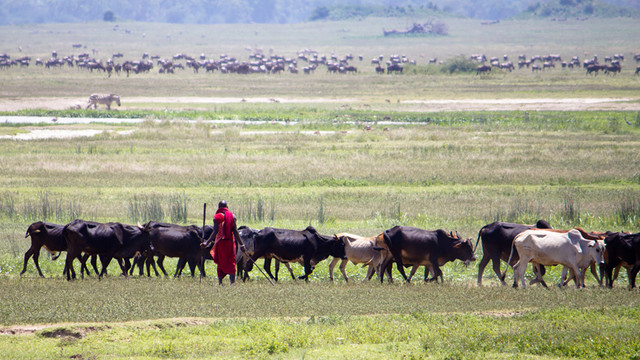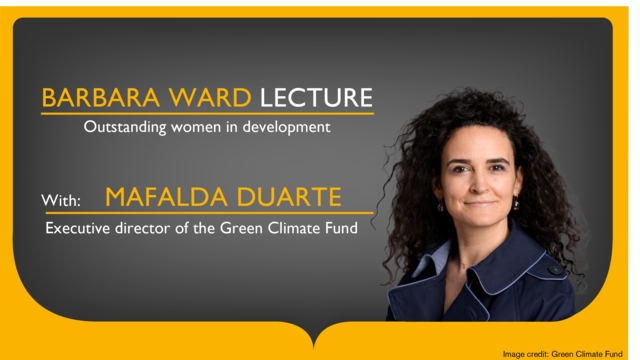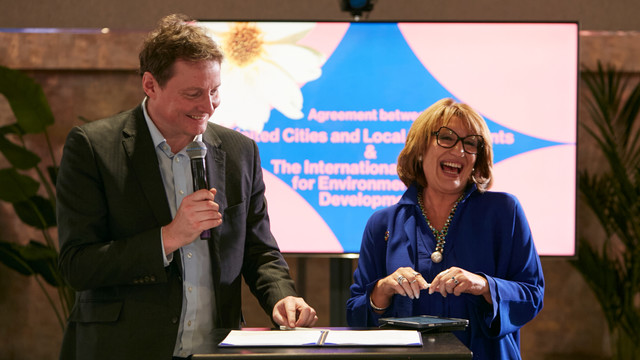Ecosystem-based adaptation: three ways evidence can influence policymakers
Ecosystem-based adaptation (EbA) involves people working with nature to adapt to the adverse effects of climate change. Evidence from locally led EbA is essential for designing successful international and national climate, nature and economic policies.


Landscape in Namaqualand in the Namakwa district, South Africa (Photo: Julia Levin)
During a project spanning seven years, IIED and partners collaborated to improve the evidence of ecosystem-based adaptation's (EbA) effectiveness and to inform policies and actions for climate, nature and people.
As this work drew to a close, IIED spoke with three organisations who are championing integrated approaches for climate and nature, like EbA, in China, Peru and South Africa.
Their reflections on their own policy-influencing work and on the two major climate and biodiversity international policy-setting forums towards the end of last year – the UN climate (COP27) and biodioversity (COP15) negotiations – point to three concrete ways that EbA practitioners can work to secure greater support and policy uptake of these approaches.
1. Spotlight Indigenous and local knowledge and actions
In many countries around the world, Indigenous Peoples and local communities who have done the least to cause climate change are bearing the brunt of its impacts. Yet many are investing their time and money working with nature to adapt, often building on their traditional knowledge and biocultural heritage.
A recent IIED survey in China found that farming households invest 20-40% of their annual income in trialling and implementing ecological farming practices to adapt to climate change. Farmers in remote and climate vulnerable areas spend around 60-80% of their income on these activities.
However, local experiences and knowledge are not sufficiently reflected in policy design and implementation.
“Developing countries made significant commitments at COP15, but there is little clarity as to how these will be met,” said Mirella Gallardo, executive director of the Instituto de Montaña in Perú.
IIED’s research on EbA effectiveness found that using participatory processes that promote local ownership and are based on local culture and priorities bring more sustainable benefits and can help governments deliver against biodiversity and climate targets.
“Participatory EbA approaches can help bring communities into the fold. EbA can also show that traditional technologies and ways of managing critical resources, such as water, deliver benefits and are already trusted by communities,” added Gallardo.
EbA practitioners can also bring valuable first-hand experience of what is happening on the ground to international policy forums, as Gallardo explained: “Damage to livelihoods, for example, is not only caused by increases in the frequency and intensity of climate and weather extremes, like hot extremes on land and in the ocean, heavy precipitation events, drought and fire weather,” said Gallardo.
“In the Andes, frosts intensity, frequency and seasonality have changed, destroying sowings and the productivity of pastures, yet there is not enough knowledge and discussions of these impacts,” she concluded.

Gallardo shared lessons from EbA approaches in Perú’s mountains at an event hosted by the Mountain Partnership and IPCC member Carolina Adler during COP27 (Photo: Mountain Institute)
2. Contribute practical solutions to complex problems
The complexity and extent of the triple climate, nature and poverty crisis is overwhelming. At times, this can delay or even paralyse action.
EbA practitioners possess evidence of effective measures that tackle the interconnected challenges of biodiversity loss and climate change and can help policymakers and other stakeholders overcome some impasses.
"We collaborated with the [South African] COP15 delegation during the public consultation process by sharing evidence from our work in South Africa," explained Charissa da Costa, regional climate policy specialist at Conservation South Africa (CSA).
"We presented how the EbA approaches implemented by local governments in the Northern Cape and other areas were bringing about positive outcomes for communities, conservation, and climate adaptation. We hope our contribution helped inform the government's decision to adopt the [global biodiversity] framework."

Da Costa at a Conservation South Africa training workshops in Namaqualand (Photo: Ronald Newman)
Another challenging aspect is how to finance climate and nature commitments. IIED’s research shows that EbA can deliver economic benefits to a wider range of stakeholders than alternative adaptation measures, such as constructed seawalls. But not enough financing – public or private – is reaching local stakeholders to implement EbA interventions.
Sharing evidence of finance interventions that have successfully supported EbA is more critical than ever.
“Local governments are often expected to fund local projects, and often do not have the resources and capacity to do so,” added da Costa. In addition to public expenditure, South Africa has received substantial investment through funds such as the Adaptation Fund administered by the Small Grants Facility project.
A CSA case study charted how this project supported communities to implement EbA in the Namakwa district of South Africa. The grants aimed to develop community-based adaptation pilot projects that reduced their vulnerability and increased their resilience to climate change. These communities are largely dependent on natural resources to support their livelihoods through small-scale farming and fishing, making them vulnerable to the impacts of climate change.
"This case study showed that communities can take charge... if alternative financing mechanisms are accessible, communities can mobilise to finance and execute the projects themselves,” added da Costa. CSA provided support and guidance to communities as the implementing agent, particularly to develop governance structures. Funding for this support was critical.
3. Build strength in numbers
While there is clear evidence of the effectiveness of EbA, policymakers still have a way to go to recognise its potential for delivering benefits for communities, nature and climate adaptation.
“Ecosystem-based approaches are still not a mainstream issue at the COPs,” said Xin Song, a youth leader with the Farmers’ Seed Network in China (FSN-China). “The final text at COP27 didn’t make a specific reference to EbA and how it can contribute to adaptation.”
Similarly, the voices and perspectives of the communities that are already bringing benefits to people and nature are not yet a part of the main discussions at the COPs.
“We would have liked to see small-scale farmers at COP27 talking about what they have done for adaptation,” added Xin Song. “They are not included in national delegations, so their countries’ negotiators are not speaking to their needs and priorities.”

Xin Song and the Farmers’ Seed Network team, with partners from IIED, at COP15 (Photo: Farmers’ Seed Network)
But meaningful participation of small-scale farmers and other community leaders can be challenging and requires substantive preparation and resources.
“A network of local NGOs that understands the process and understands the power at play in these forums can support local actors to navigate international policy spaces and make sure their voices are heard,” concluded Xin Song. Working with local partners like FSN-China, IIED continues to support the inclusion of local voices in international and national forums.
Championing EbA initiatives that work and getting these recognised in policy will bring benefits to climate, nature and people. EbA practitioners can prove – and many already are – that locally led initiatives harness biodiversity and ecosystem services to support climate adaptation, and do so in ways that are also cost-effective.
The question remains: are policymakers ready to listen?
From 2016-22, IIED, the International Union for the Conservation of Nature (IUCN) and the UN Environment World Conservation Monitoring Centre (UNEP-WCMC) implemented the project 'Ecosystem-based approaches to climate change adaptation: strengthening the evidence and informing policy' (EbA evidence and policy). Working with local partners in 12 countries, the project gathered practical evidence and developed policy guidance on how EbA can best be implemented. Reports, case studies, multimedia storymaps and many other resources are available on the project page.



